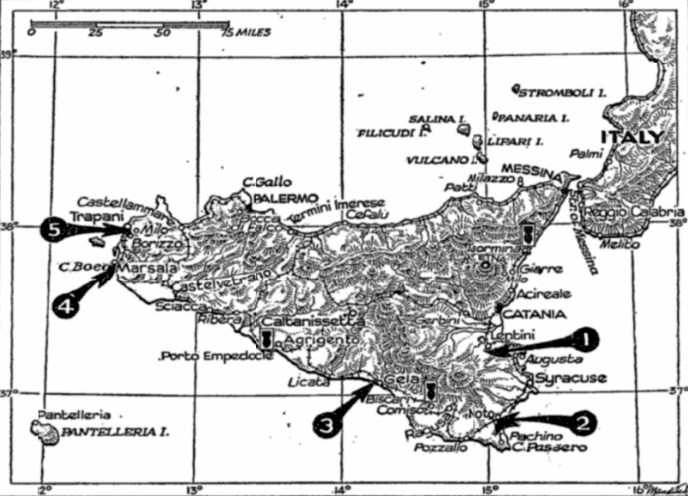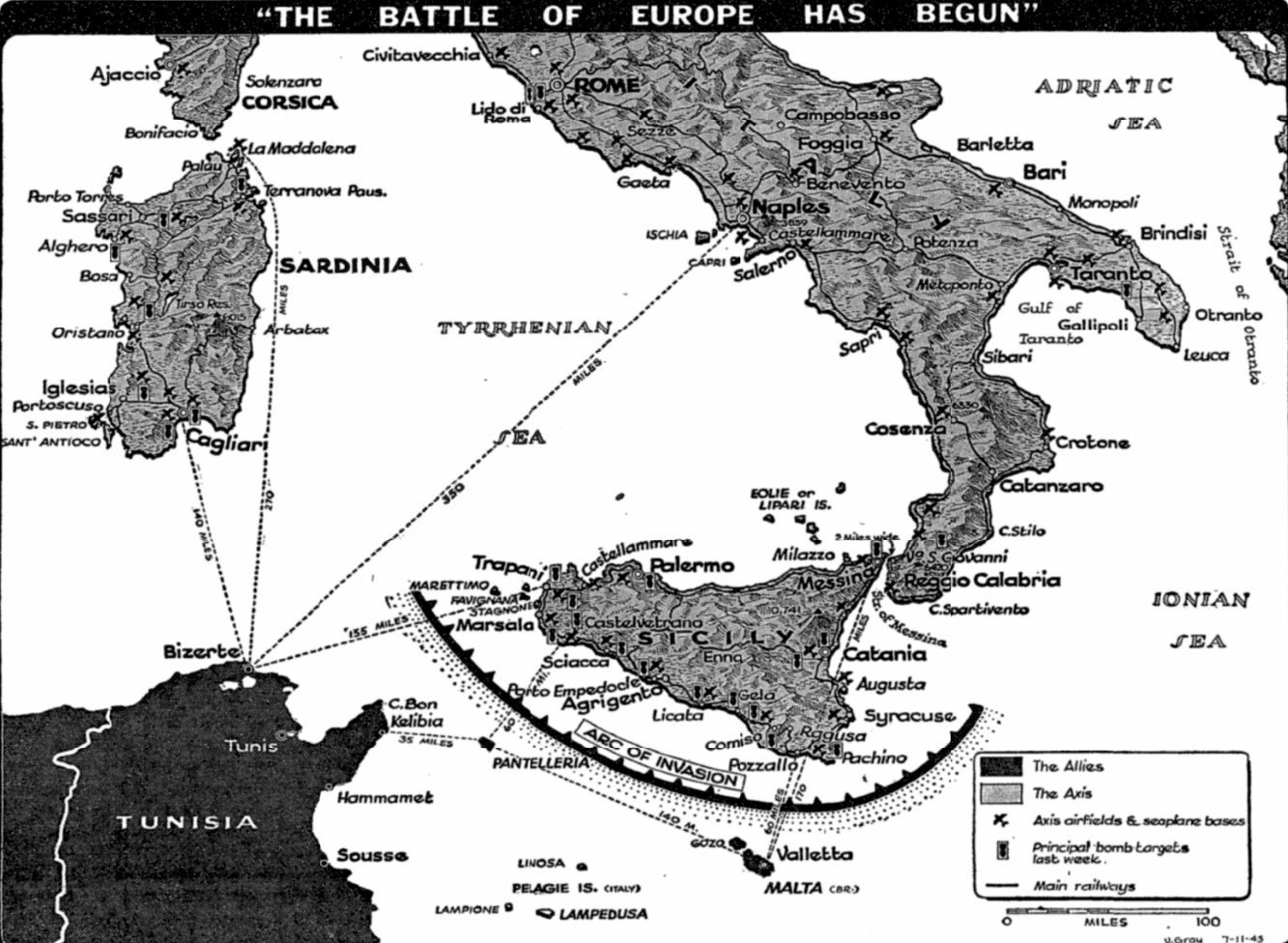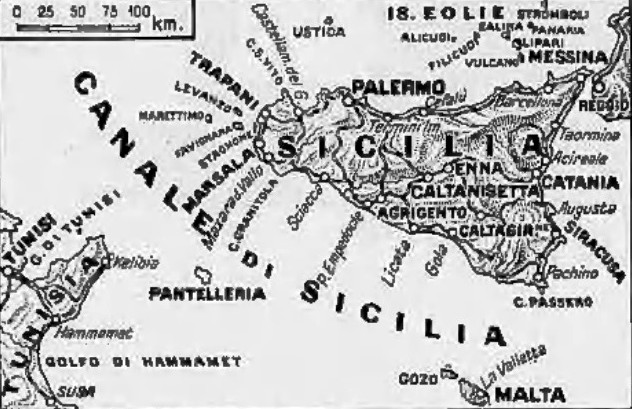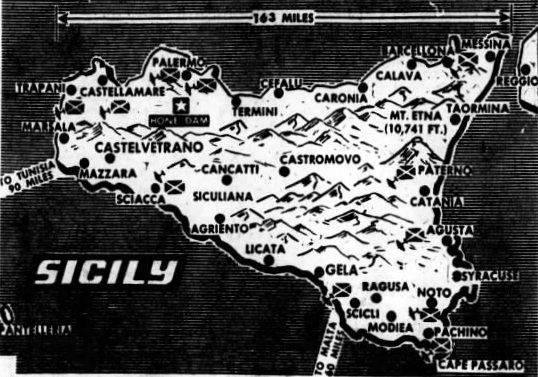The New York Times (July 11, 1943)
Weakest spot is hit; new invasions hinted in Washington, London and North Africa
By Drew Middleton
Allies fight way inland from Sicilian beachheads

Landing along 100 miles of Sicily’s southeastern coast, U.S., British and Canadian forces battered forward against determined opposition as Allied ships continued to pour men ashore. Axis reports said the invaders had driven to the inland edge of the plain between Catania and Syracuse (1), had taken Noto (2) and battling for nearby Pachino. These reports also told of landings at Gela (3), at Capo Boeo (4) and in the Trapani region (5). In aerial assaults immediately preceding the invasion, U.S. bombers demolished Axis general headquarters at Taormina and smashed the Comiso Airdrome. Porto Empedocle was also a target.
Allied HQ, North Africa – (July 10)
U.S., Canadian and British troops smashed forward on a 100-mile front in southeastern Sicily today, heralded by a tremendous aerial offensive against enemy communications and airfields.
The first stage of the invasion of Sicily ended successfully at 6 a.m. today, when, after three hours of savage fighting on the beaches and intensive shelling by cruisers, destroyers and gunboats, the Axis coastal defense batteries were shattered and the success of all the landings was assured.
Men and arms pour ashore
By 7:30 a.m., Allied infantrymen, their bayonets bright in the morning sun, were hacking their way inland through the enemy defenses and artillery was rumbling up the beaches to answer the Axis guns barking from the hills. Fierce fighting continued throughout the day. Fresh troops, guns and equipment poured ashore from landing craft and transport of the British and U.S. Navies.
The Allies landed between Syracuse and Catania, according to a Vichy broadcast recorded by Reuters in London. Other Axis reports, relayed from Berne, told of landings at Capo Boeo and in the Trapani area, in the western part of Sicily, and at Gela, in the southeast.
Later enemy reports located the main battle area somewhere between Syracuse and Capo Passero, to the south. They said that heavy fighting was going on at Pachino, while the town of Noto had been captured. Reports from France, quoted by the United Press, said that the Allies were in close contact with Axis troops on the inland edge of the plain between Catania and Syracuse.
In Washington, there were hints of an imminent attack on the Italian mainland itself, while London sources, according to the United Press, said that the attack on Sicily was not to be regarded as “the only landing.” An Associated Press dispatch from Allied headquarters in North Africa said that “other offensives may be in the offing.
It was apparent tonight that, although Sicily was far from conquered, the Allies had scored a signal success in the first day’s operation and that only a very strong and determined counterattack could halt their steady progress north from the southeastern corner, where they had landed on beaches and landing points extending over 100 miles.
Weather unfavorable
A heavy swell in the Sicilian Channel, where the landing craft rolled drunkenly, and unfavorable weather conditions in general did not halt the Allied attack. Almost two months after the eviction of the enemy from Africa, Old Glory and the Union Jack were planted on metropolitan Italian soil.
As the landing craft grated on the beaches, men of the U.S., British, Indian, Dutch, Polish and Greek Navies sent hundreds of shells over the beaches onto the batteries, pillboxes and rifle-pits on which the enemy defense or the bridgeheads depended. But the naval operations did not halt with the thunderous support of the landing forces. “Widespread naval operations” are continuing in the Central Mediterranean area.
The Rome radio, heard by the United Press in London, said that Italian naval forces had gone into action off Sicily and that Italian torpedo-bombers had damaged three invasion transports totaling 29,000 tons.
All the resources of the Allied navies in these waters were thrown into the support of the landing operations. As important, but less glamorous, was the work of the thousands of seamen aboard the transports and landing-craft who brought their ships through a hail of bombs to the appointed places and guided the landing-craft toward the gunfire from the coast.
Most vulnerable area
The Allies landed in what is probably the most strongly defended and certainly the most vulnerable corner of Sicily. For not only are the forces landing on the southeastern corner within striking distance of airdromes like Comiso, which is about 10 miles from the sea, but they are about 60 miles from Catania, the main port on the eastern coast; roughly 55 miles from the mammoth air base at Gerbini – one of the few still in operation – and 30 miles from Syracuse, one of the best ports on the east coast.
The resistance offered to the Allied troops today was stiff. There are a large number of Italian troops, including field and semi-static coastal divisions, and a large number of corps troops, such as coastal defense and anti-aircraft artillery, on the island. These have been stiffened by crack regiments originally intended for Tunisia, but switched to Sicily when the Germans were defeated in Africa.
Despite the fluidity of the tactical situation, it was clear that Anglo-American cooperation in the most difficult of all military operations – a landing on a hostile coast – had denied the enemy the use of Sicily as a submarine and air base and that the Allied troops were driving forward toward the airfields.
The first line of the Sicilian defenses has been pierced. The Germans must now launch counterattacks strong enough to halt the Allies before they can secure any of the large ports through which the remainder of the huge and varied Allied force can pour.
There is every prospect of harder fighting ahead, especially if the Allies push toward the northeastern corner of the island, which, since its main port, Messina, is closest to Italy, is the most important enemy supply area. Messina is guarded by a mountain chain running from east to west across the northern half of the island, a chain that appears to offer the same difficulties as the Tunisian hills.
At 3 a.m. today, U.S., Canadian and British troops, escorted and supported by a strong British naval force and a “token” American squadron and preceded by an armada of Allied planes, began what is believed to be the most important, hazardous and delicate operation yet attempted by the Allies in this war.
Vital to next moves
Not only is the invasion of Sicily the first step in the storming of Europe; its possession will give the Allies military advantages, without which further operations in the Central Mediterranean area would be almost impossible. The fighting in North Africa, for three years, was a struggle for air bases. This is again true in Sicily. Once Allied bombers are taking off from such fields as Gerbini and Comiso, the air battlefront will extend into northeastern Italy and the Adriatic.
The capture of these airfields would remove any remaining threat from the air to Allied convoys passing through the Sicilian Channel.
Hazards explained
The Allied offensive that opened this morning is hazardous and delicate for three reasons. First, the enemy has prepared the defenses of Sicily for just such an attack. Second, strategical surprise – that is, surprising the enemy by the invasion of Sicily – was almost impossible after weeks of very heavy aerial bombardment. Third, tactical surprise – that is, fooling the enemy as to the bridgeheads selected – became impossible at dawn.
There are no reports of any incident like the encounter with a German convoy off Dieppe that ended any chance of tactical surprise there. But it is unlikely that the enemy’s aerial patrols did not sight the vast armada moving toward Sicily during the night.
First reports encouraging
Allied HQ, North Africa (UP) – (July 10)
Surging ashore from wave on wave of landing craft, U.S., British and Canadian assault troops opened the invasion of Sicily at 3 a.m. today. In the first critical hours of the operation, there were no official details of its progress or even a designation of the landing points and immediate objectives. But, as the hours passed, the feeling of quiet confidence around Allied headquarters indicated that all was going according to plan and the first eyewitness reports of the attack were optimistic.
Reconnaissance photographs of the first stages of the battle, developed at an advanced airdrome, showed a spectacle hardly paralleled in this war as Allied warships laid down vast smokescreens and pummeled shore batteries while the troops scrambled onto Sicily’s rocky headlands. Barge-load after barge-load of troops drove onto the shore under a withering barrage from the coastal guns, which were also turned against Allied destroyers as they ran close inshore to cover the debarkation from transports to landing craft.
Violent aerial bombardment of Sicilian installations continued today. Allied fliers concentrated on the few airdromes still in use by the enemy, and on roads and other communications. They met little opposition.
The Allied fleet bearing the invasion army was made up of hundreds of ships spearheaded by fast destroyers and heavily-armed cruisers, and included a great many of the latest-type landing barges. Many of these latter were understood to be huge tank-landing craft that came over the high seas from Britain or the United States under their own power.
The Allies completed their initial landings without the loss of any ships, the Associated Press reported. The vessels encountered neither submarine nor air attacks.
Under the invasion plan, the first troops ashore would be engineers and sappers carrying automatic arms and Bangalore torpedoes, small pipe-like grenades for blasting breaches in the barbed-wire that the Italians were reported to have planted thickly on the Sicilian shores. The proportion of U.S., British and Canadian troops was not disclosed. Hardened for this battle in prolonged maneuvers in England, the Canadians were believed to include veterans of the bloody clash at Dieppe.
The invasion was a landing operation of a scope unsurpassed in this war or in military history. The Axis invasion of Crete was a thumbnail venture by comparison, while the overrunning of the Pacific Islands by Japan was far simpler because of the weakness of the Allied defenses.
There were no illusions here that the Sicilian campaign would end in a few hours or without a heavy cost. Some 300,000 of Italy’s toughest fighters man the island’s defenses, bolstered by a German shock force of uncertain size, but possibly as many as 100,000 men.
Preceded by day of bombing
An Allied Force Command post, North Africa (AP) – (July 10)
The Northwest African Air Forces paved the way for Allied landings in Sicily by heavy bombing of the island’s airfields, communications, radio installations and defense emplacements yesterday.
Increased enemy fighter opposition was encountered. Fifteen enemy planes were shot down and others were destroyed on the ground. The Allies lost 10 planes.
Island headquarters razed
Cairo, Egypt – (July 10)
Only a few hours before dusk yesterday, before the Allied invasion force had set sail for Sicily, a flight of U.S. Liberators made a sudden slashing attack on the Axis headquarters on the island, completely demolishing both the general headquarters and the communications buildings at Taormina.
It is probable that the Sicilian defensive nerve center was paralyzed, at least for some valuable hours.
This became known here this morning almost simultaneously with the first details of the invasion.
The bombers unloaded heavy explosives and incendiaries on the San Domenico Hotel, which is believed to house the Axis headquarters, and on the post office building, in which all telephone, telegraph and the communications facilities are established, and completely demolished both by a concentrated series of direct hits, a communiqué said. Huge fires were left burning and a mass of rubble was all that was left, according to returning pilots. The bombers also battered railway tracks at Taormina and the Comiso Airdrome.
Other big bombers attacked the Maleme Airfield, the largest in Crete, where the Germans first established their foothold during that island’s invasion. The attack came only a few days after the British raiders’ landings on Crete. Almost 100 U.S. bombers took part in these sallies and one was lost.



